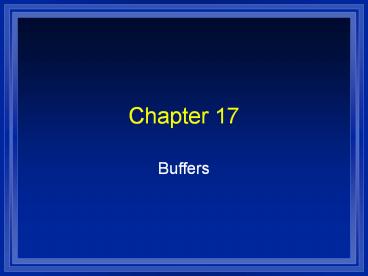Buffers PowerPoint PPT Presentation
Title: Buffers
1
Chapter 17
- Buffers
2
Buffered solutions
- A solution that resists a change in pH.
- Buffers are
- A solution that contains a weak acid-weak base
conjugate pair. - Often prepared by mixing a weak acid, or a weak
base, with a salt of that acid or base.
3
Buffered solutions
- The solution has the ability to resist changes in
pH upon the addition of small amounts of either
acid or base. - We can make a buffer of any pH by varying the
concentrations of these solutions.
4
What is the pH of a buffer that is 0.12M in
lactic acid, HC3H5O3 , and 0.10M in sodium
lactate? For lactic acid, K 1.4 x 10 -4
HC3H5O3 ? H
C3H5O3-1
I 0.12 M 0 0.10 M
C -x x x
E 0.12 x x 0.10 x
5
- H 1 C3H5O3-1
- Ka HC3H5O3
- 1.4 x 10-4 (x) (0.10 x)
- (0.12 x)
- Because of the small Ka and the presence of the
common ion, it is expected that x will be small
relative to 0.12 or 0.10M. - x 1.7 x 10 -4 M therefore H1 1.7 x 10
-4 M - pH -log (1.7 x 10 -4 M) 3.77
6
Use Henderson-Hasselbach Instead
- base
- pH pKa log acid
- 0.10
- pH -log (1.4 x 10-4) log 0.12
- pH 3.85 (-0.08) 3.77
7
Practice Problem
- Calculate the pH of a buffer composed of 0.12M
benzoic acid (HC7H5O2)and 0.20M sodium benzoate.
Ka 6.3 x 10-5 - ans 4.42
- Remember the Aqueous Equilibrium Constants are
located in Appendix D of your textbook.
8
Buffered Solutions
- Buffers resist changes in pH because they contain
both an acidic species to neutralize OH-1 ions
and a basic one to neutralize H1 ions. - It is important that the acidic and basic species
of the buffer do not consume each other through a
neutralization reaction.
9
Buffered Solutions
- HA H A-
- Ka H A- HA
- Buffers most effectively resist a change in pH in
either direction when the concentrations of HA
and A- are about the same. When HA equals A-
then H equals Ka. - Scientists usually try to select a buffer whose
acid form has a pKa close to the desired pH.
10
General equation
- Ka H A- HA
- so H Ka HA A-
- The H depends on the ratio HA/A-
- Take the negative log of both sides
- pH -log(Ka HA/A-)
- pH -log(Ka)-log(HA/A-)
- pH pKa log(A-/HA)
11
This is called the Henderson-Hasselbach equation
- pH pKa log(A-/HA)
- pH pKa log(base/acid)
12
Try an Acid
- Calculate the pH of the following mixture
- Prob. 1
- 0.75 M lactic acid (HC3H5O3) and 0.25 M sodium
lactate (Ka 1.4 x 10-4) - Answer
- pH -log(1.4x10-4) log0.25/0.75
- pH 3.38
13
Now Try a Base
- Calculate the pH of the following mixture
- 0.25 M NH3 and 0.40 M NH4Cl
- (Kb 1.8 x 10-5)
- Answer
- NH3 NH41 OH-1
- (NH3 is B, NH41 is HB1)
- pOH pKb log HB1 / B
- pOH -log(1.8x10-5) log0.4/0.25
- pOH 4.94 now convert to pH
14
Buffering Capacity
- This is the amount of acid or base the buffer can
neutralize before the pH begins to change to an
appreciable degree.
15
Buffering Capacity
- The buffering capacity, that is, the
effectiveness of the buffer solution, depends on
the amount of acid and conjugate base from which
the buffer is made. - The larger the amount the greater the buffering
capacity. - In general, a buffer system can be represented as
salt-acid or conjugate base-acid.
16
Buffer capacity
- The pH of a buffered solution is determined by
the ratio A-/HA. - As long as this doesnt change much the pH wont
change much. - The more concentrated these two are the more H
and OH- the solution will be able to absorb. - Larger concentrations means bigger buffer
capacity.
17
Buffer Capacity
- Calculate the change in pH that occurs when 0.010
mol of HCl(g) is added to 1.0L of each of the
following - 5.00 M HAc and 5.00 M NaAc
- 0.050 M HAc and 0.050 M NaAc
- Ka 1.8x10-5
18
Buffer capacity
- The best buffers have a ratio A-/HA 1
- This is most resistant to change
- True when A- HA
- Make pH pKa (since log10)
19
Addition of Strong Acids or Bases to Buffers
- See pg. 648 BL for explanation and examples.
20
Adding a strong acid or base
- Do the stoichiometry first.
- A strong base will take protons from the weak
acid reducing HA0 - A strong acid will add its proton to the anion of
the salt reducing A-0 - Then do the equilibrium problem.
21
B L pg 649
22
(No Transcript)
23
(No Transcript)
24
(No Transcript)
25
- Try the Buffer worksheet from the Chang
chemistry text.
26
Prove theyre buffers
- What would the pH be if 0.020 mol of HCl is added
to 1.0 L of both of the preceding solutions. - What would the pH be if 0.050 mol of solid NaOH
is added to each of the proceeding.
27
- Thanks to Mr. Green

